Chicago 1919: a citywide conversation about past and present racial violence
12 October 2020 – Karen Christianson
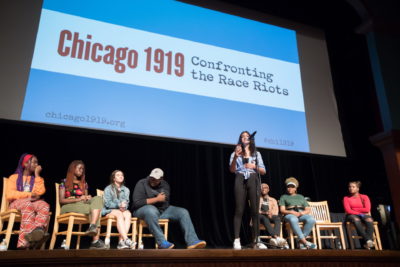
Apprentices from Young Chicago Author’s Louder Than a Bomb Squad Summer Program perform at the “Reflections of Youth: Spoken Word Performance and Conversation” event, August 12, 2019, Harold Washington Library Center. Photo credit: Anne Ryan.
Editor’s note: This essay is part of a series of reflective posts written by winners of awards intended to be given out at the NCPH 2020 annual meeting in Atlanta, Georgia. The “Chicago 1919” project, organized by the Newberry Library, received 2020 Outstanding Public History Project Award.
Throughout 2019, the Newberry Library’s year-long, NEH-funded initiative, “Chicago 1919: Confronting the Race Riots,” explored the week of violent conflicts in the Windy City and its lasting significance today. The race riots, which were the most violent week in Chicago history, were sparked by the murder of Eugene Williams, an African American teenager stoned and drowned by a white man for floating his raft over an invisible line into a whites-only beach. Police refused to arrest the perpetrator, and the city erupted in arson, looting, and 38 deaths—23 Black, 15 white—until the National Guard restored order. The riots inflicted lasting scars, still visible in the lines of racial segregation throughout the city’s built environment, its schools, and its selective policing. The events in Chicago took place in the context of white supremacist terrorism against African Americans that tore apart more than 30 cities across the U.S. that year. James Weldon Johnson, field secretary for the National Association for the Advancement of Colored People, dubbed the widespread violence the “Red Summer.”
The year 1919 was not the last episode of private vigilante or state-directed anti-Black violence in Chicago in the twentieth century—other notable episodes differed in degree but not in kind. For example, historian Arnold Hirsch called the 1940s and ’50s the “era of hidden violence,” during which white residents terrorized Black residents, or those attempting to become residents of certain neighborhoods, often with the aid or tacit approval of the police. And in the twenty-first century, it remains clear that Chicago has a long way to go in this regard. A series of shootings of Black men by Chicago police officers, from Laquan McDonald in 2014 to the wounding of Latrell Allen in August of this year, led to the rise in Chicago of one of the nation’s most active Black Lives Matter movements. In the wake of last spring’s murder by a police officer of George Floyd in Minneapolis, thousands of Chicagoans of all races have participated in weeks of vast protest marches.
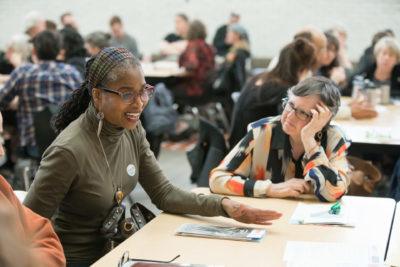
Audience members share stories about their own experiences with moving and migration during a “Story Circle” activity, “Migration and Housing: A Century of Color Lines,” May 4, 2019, at the Homan Square Power House on the city’s West Side. Photo credit: Anne Ryan.
As we approached the centenary of the 1919 riots, a group of Newberry staffers began to think about ways to both commemorate them and explore the longer history of how Chicago got from there to its current circumstances. We soon realized that city residents remained largely unaware of this history and its aftermath. When Newberry public engagement, research centers, and curatorial staff first discussed the project in 2017, many who grew up here confirmed they had never heard of these events. We reached out to area museums and other cultural institutions and discovered, to our surprise, that no one planned to explore the legacy of the riots during the anniversary year—though everyone we talked with responded enthusiastically to the notion. What began as an idea to produce one or two routine programs at the Newberry blossomed into a far more expansive project, drawing on the expertise of organizations across the city.
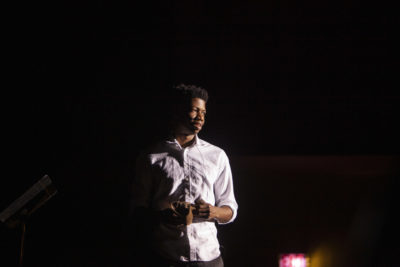
Jabari Chiphe as Eugene Williams, at the opening event on February 23, 2019, at DuSable Museum of African American History. Photo credit: Bradley Murray Photography.
The Newberry coordinated the project in partnership with thirteen other Chicago institutions. We started by setting up meetings with staffers we had previously worked with on other projects at such organizations as DuSable Museum of African American History, Chicago History Museum, Black Metropolis Research Consortium, and the Chicago Collections Consortium. We also talked with scholars from a variety of disciplines with expertise in historical aspects of the riots; eight of these became advisors for the project. As we moved into planning specific kinds of events and digital resources, we reached out to other institutions, often at colleagues’ suggestions. Over several weeks we added as cultural partners the Chicago Urban League, Young Chicago Authors, Black Chicago History Forum, Chicago Public Library, City Bureau civic media lab, Kartemquin Films, Middle Passage Productions, Blackstone Bicycle Works, and Chicago Architectural Club.
The resulting year-long project aimed to heighten awareness of the 1919 Chicago race riots in the city’s collective memory and to engage Chicagoans in public conversations about the legacy of that violent week. The partners’ collective mission aspired to stimulate a broader conversation across the city and the region about the nearly forgotten events of the summer of 1919 and how their legacy has shaped and continues to affect race relations in Chicago today.
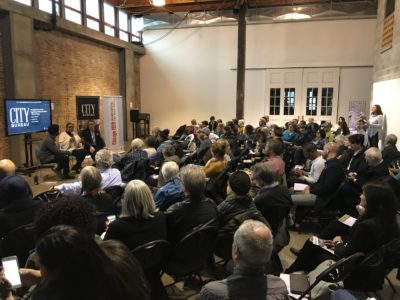
“Reporting on Race: From The Chicago Defender and Carl Sandburg to Chicago Journalism Today” event, April 4, 2019, at City Bureau on Chicago’s South Side. Photo credit: Brad Hunt.
At the project’s heart were eleven dynamic public programs that encouraged audiences to examine the mechanisms through which segregation and inequality have been created, solidified, and reinforced over the past hundred years. Each event focused on a specific expression of institutionalized racism—from policing and education to housing, literature, and media. In addition to providing history-based information about each topic, a variety of interactive approaches directly engaged participants: breakout sessions, instant smartphone polling, facilitated story circles, a guided bicycle tour through neighborhoods affected by the riots, soapbox speeches, and a youth poetry slam. The 64 program speakers or leaders included both cutting-edge scholars digging into the city’s history and grass-roots community leaders who told their own stories, connecting the past to present struggles. Nearly 2,700 people attended the programs, held at eight locations throughout the city; many events were live-streamed and are available on the Newberry’s YouTube channel.
The Newberry and partners also created a series of digital resources including a website, a video, teachers’ resources, an online exhibition, an interactive map pinpointing locations of injuries and deaths during the riots, and a self-guided tour of neighborhoods affected (using the Vamonde app). Anya Davidson, a well-known Chicago cartoonist, also attended events, interviewed audience members, and created a multi-panel graphic strip for each program. All of these resources, along with recordings and information about the project’s partners, advisors, events, and media coverage, are available on the project’s website.
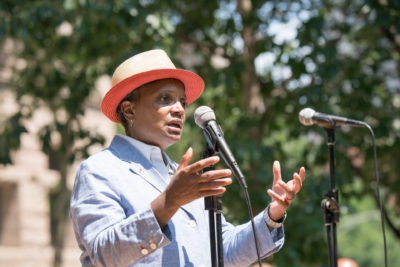
Mayor Lori Lightfoot speaks about the legacy of the race riots at the “Bughouse Square Debates: Legacies of 1919” event on July 27, 2019, at Washington Square Park. Photo credit: Anne Ryan.
We launched the project website and video on Dr. Martin Luther King Jr. Day, January 21, 2019. Local news media and social media outlets soon picked up the story, and coverage built both locally and nationally throughout the summer. Media exposure led local community and activist groups to organize dozens of additional 1919 events and exhibitions. Chicago’s new mayor Lori Lightfoot hosted a city-sponsored commemorative event attended by city alderman, officials, and community leaders. The mayor mentioned our project during her remarks and announced the creation by Chicago Public Schools of a unit about the 1919 riots that will become a permanent part of its history curriculum.
In addition, the PBS history series The Future of America’s Past produced an episode focusing on the 1919 Chicago riots and our project’s role in uncovering that past for the public. Camera crews filmed some of our events and interviewed several scholars, partners, and community members involved with our project. The documentary movingly traces the outline of the riots themselves, their legacy, and commemorative activities. It includes the voices of Juanita Mitchell, a 107-year-old survivor of the riots, local activists, community members, and poet Eve Ewing.
In short, “Chicago 1919: Confronting the Race Riots” added a new dimension to conversations about race in Chicago. Each program demonstrated that the city’s current challenges—housing segregation, inequitable public school quality, decades of disinvestment in primarily Black neighborhoods, unequal treatment in the media, and selective policing—were not inevitable. These obstacles to full equality were carefully and deliberately orchestrated by white policymakers over the decades after the riots, with overwhelming support from white residents.
The events of 1919 could not have marked a watershed moment tipping the nation toward equality for African Americans; support among the majority population was simply lacking. However, widespread reactions to current events by Americans of all backgrounds suggest a significant shift in public opinion about racial issues may be underway. Public history projects like this one can provide insight into the background and causes of current inequities, which is essential to finding ways to dismantle them.



